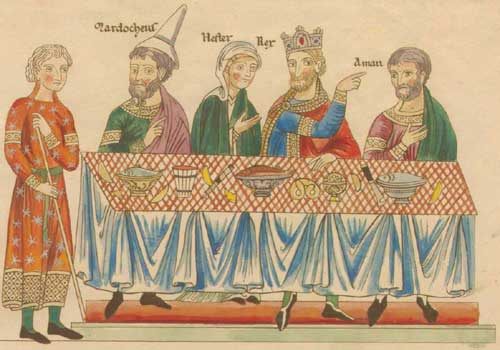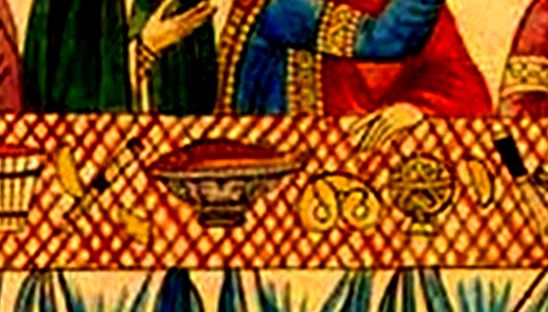The First Encyclopedia by a Woman Contains The First Image of a Pretzel
In the 12th century, pretzels were for kings apparently.

Can you find the very first pretzel? (Photo: Christian Maurice Engelhardt/Public Domain)
Newspaper obituaries around the globe are filled with firsts: first American woman in space (Sally Ride)*, first person to circumnavigate the globe (Ferdinand Magellan), first printed bible (The Gutenberg Bible).
And then there’s the painting believed to the world’s first depiction of a pretzel.
The Hortus Deliciarum is like a handbook of questionable firsts, standing as the first encyclopedia to be authored by a woman, as well as holding what may be the earliest depiction of a pretzel the world has ever seen. “They are in scenes that are meant to portray elaborate and luxurious banquets,” says Danielle Joyner, author of the book, Painting the Hortus deliciarum: Medieval Women, Wisdom, and Time.
An illuminated encyclopedia that dates back to the 12th century, the tome, the title of which is Latin for “Garden of Delights,” covered a wide range of topics, from a retelling of the Biblical history of the world to the scientific interests of the day. Meant to serve as a primer for young nuns and abbesses entering the service of the Hohenburg Abbey, a convent perched atop an Alsatian peak, much of the knowledge and writing contained in the text was reprinted from preexisting religious and philosophical manuscripts.
However, the author/compiler of the Hortus Deliciarum, an abbess named Herrad of Landsberg, added much more to the text. Herrad joined the convent in her youth, coming from a wealthy royal family. Hohenburg Abbey was a well-funded and respected convent that had the blessing (both spiritual and financial) of the Holy Roman Emperor Frederick Barbarossa I, allowing the education of its nuns to flourish. Herrad likely received the best possible education a woman of her time could have received, learning about music, sciences, theology, and the arts.

A vision of Hell from the Hortus Deliciarum. (Photo: GDK/Public Domain)
Herrad seems to have brought the full breadth of her education to bear when creating the Hortus Deliciarum. She began work on the volume after she became the abbess of the convent, and in addition to the writings from various classical and Arab sources that she included in the primer (presented in Latin or German, depending on the passage), she also added her own original poetry and songs. Some of the songs even included musical notation that showed evidence of polyphony (two or more melodies working in harmony) to have originated from a nunnery. Her songs and poems were usually of a religious nature, as she saw singing praises to god as her holy work.
The Hortus Deliciarum is probably best remembered by its vivid illustrations. The 300-plus images cover subjects ranging from historical vignettes to religious scenes including one particularly striking vision of a fiery hellscape. (Sorry, sinners.) While Herrad is thought to have directed the creation of the illustrations in the text, which were rich in telling detail, “The artists of the Hortus Deliciarum, likely the canonesses living at Hohenbourg in the late 12th century,” says Joyner, “gave a great deal of attention to details like luxurious clothing, the plow and a mill, and apparently the pretzel!”
It’s that last bit which makes the Hortus Deliciarum even more remarkable. Not only was this the first encyclopedia compiled by a woman, a small detail amongst some banquet scenes may be history’s very first, or oldest existing, pictures of a pretzel! One of the most referenced instances shows up in a scene depicting the Feast of Esther from the Hebrew Bible. It was during this royal banquet that Queen Esther is said to have saved the Jewish people from King Ahasuerus’ shady advisor, Haman, an event that is still remembered today by the Jewish holiday, Purim. Joyner also says that pretzels may also show up in depictions of the banquet attended by Lazarus and the Rich Man, and a scene featuring King Solomon.

A culinary first! (Photo: Dencey/Public Domain)
But why there would be pretzels in these scenes is anyone’s guess. “The other details of the banquet goodies and tools, such as the fish, the knives and spoons but lack of forks, are all representative of 12th century practices, so the pretzel may be as well,” says Joyner. She also notes that if the pastry was a new creation, it may have been seen as a treat for the wealthy, and may have acted as a quick symbol to show how rich the banquet was.
Then of course there is the possibility that it’s not that old at all. For centuries after its creation, the Hortus Deliciarum was preserved at Hohenburg Abbey, where Harrad had originally created it, but around the early 19th century, the manuscript was moved to the Library of Strasbourg. Unfortunately, during an 1870 siege, that was part of the Franco-Prussian War, the library was burned, and the original manuscript was destroyed, leaving us with only recreations of the original illuminations. The pretzel imagery could have been added during the reproduction process, but the text was extensively recorded, leaving behind a fairly complete picture of what was contained within. “It’s generally thought that these reproductions stayed as true to the original as possible,” says Joyner, “but it’s one of those disclaimers that should be attached to any discussion of the images.” History is twisted like that.
*Correction: Previously this article credited Sally Ride as the first woman in space, which was incorrect. She was the first American woman in space. The line has been corrected to reflect this.
Gastro Obscura covers the world’s most wondrous food and drink.
Sign up for our regular newsletter.



























Follow us on Twitter to get the latest on the world's hidden wonders.
Like us on Facebook to get the latest on the world's hidden wonders.
Follow us on Twitter Like us on Facebook